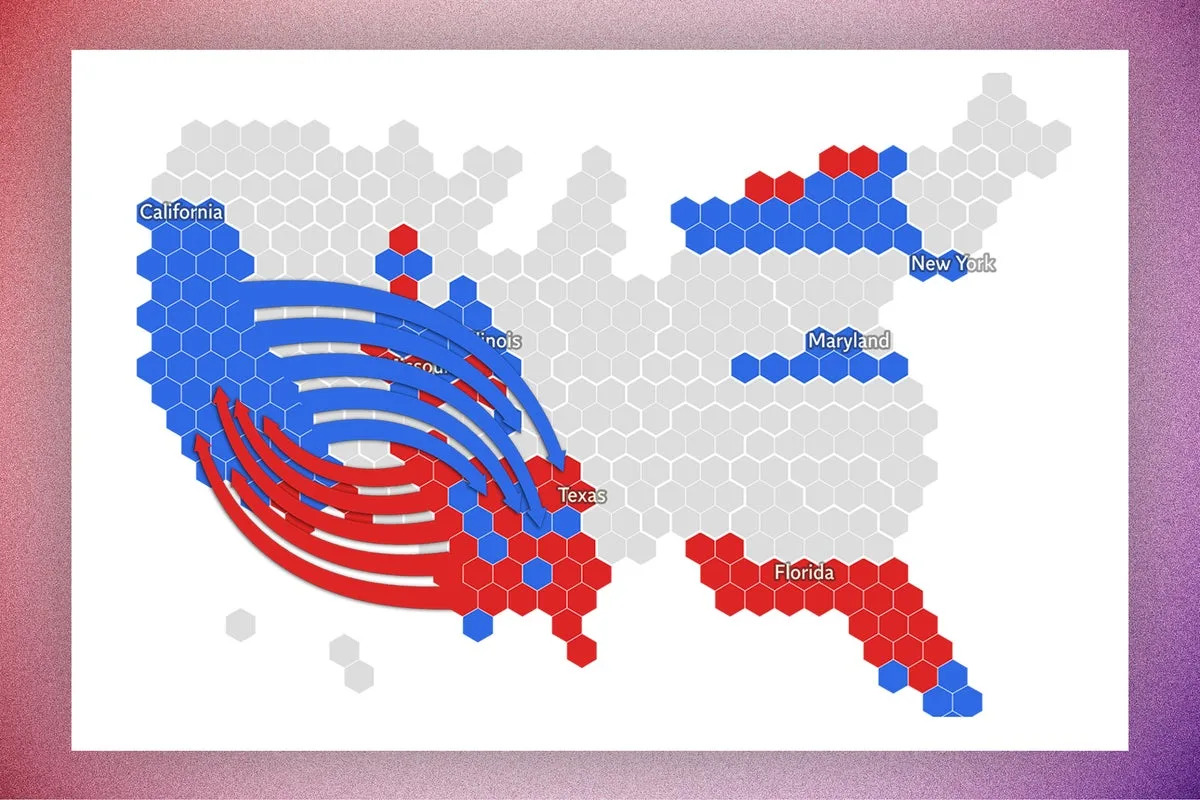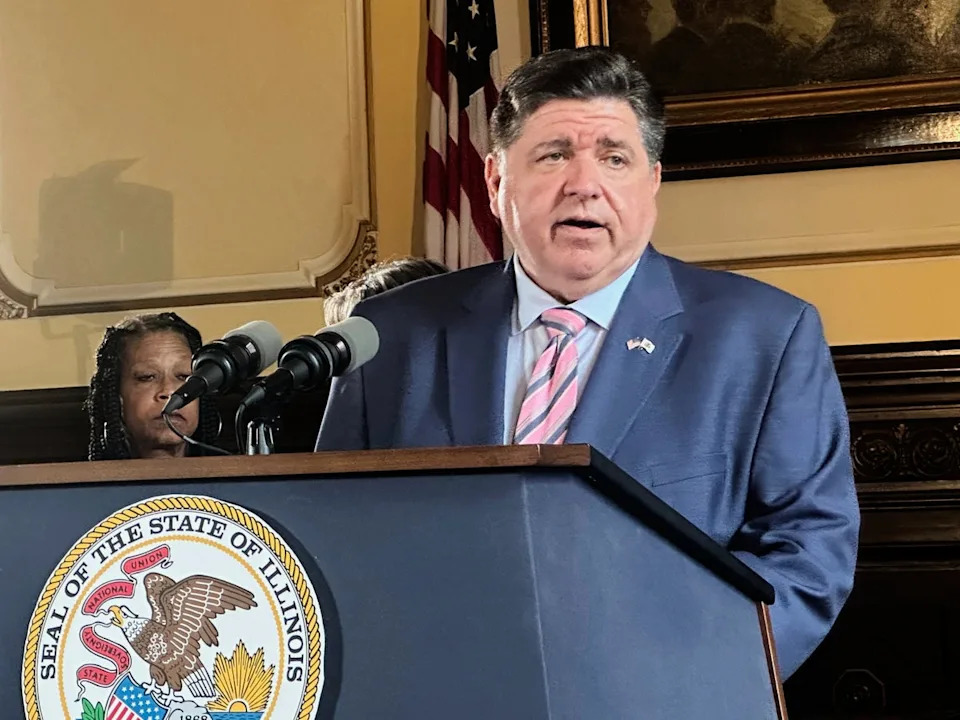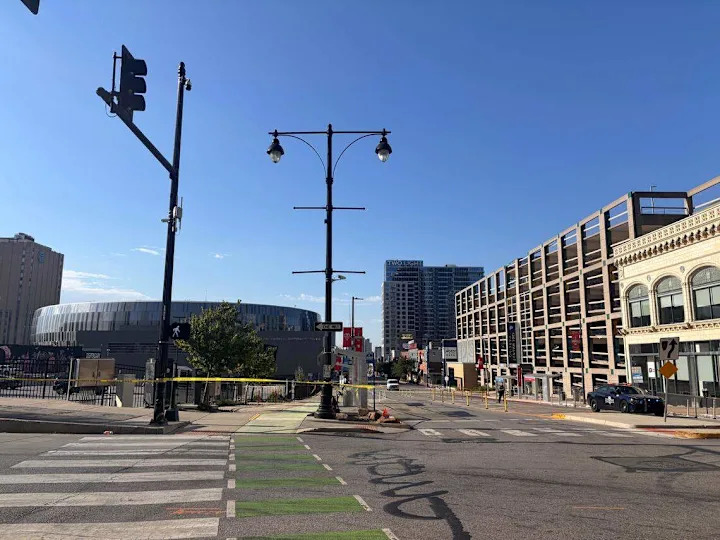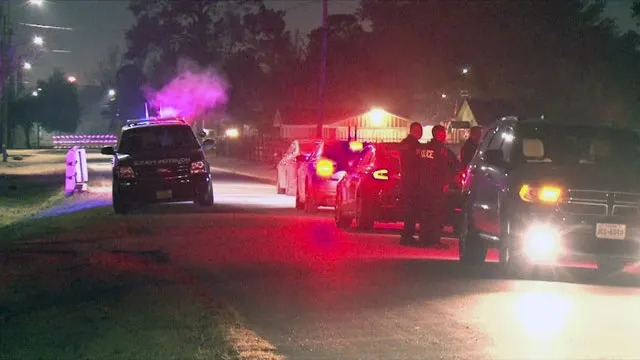
Shall we play a game?
With California threatening to meet Texas in a nationwide redistricting fight, the possibility of strike-counterstrike scenarios between red and blue states is evoking Cold War vibes. No, it’s not the nuclear missile launch nightmare faced by Matthew Broderick’s character in War Games (1983) or in Stanley Kubrick’s Dr. Strangelove — in this East-to-West spanning escalation of tensions, the driving force is control over the U.S. Congress.
To that end, Democratic and Republican lawmakers in at least half a dozen states are openly wielding the threat of mid-Census redistricting to add politically sympathetic seats in the House of Representatives ahead of the 2026 midterm elections.
It’s 2025’s nuclear option.
Behind the front lines of this war over control of the House for the last two years of Donald Trump’s presidency stand Texas Gov. Greg Abbott and California’s Gavin Newsom — aiming their political ballistic missiles at each other like John F. Kennedy and Nikita Khrushchev as the world faced the brink of nuclear annihilation during the Cuban Missile Crisis of October 1962.
The timing of this redistricting push — which reportedly stems directly from pressure put on Republicans in their respective states by Trump — is far from coincidental. Trump spent the first six months of his second term watching a bitterly divided House GOP caucus battle over his “Big, Beautiful Bill” and only narrowly averted a government shutdown in March thanks to their razor-thin majority.
He wants to close out his legacy in an easier fashion.
So, with the House up for grabs in 2026, Trump is increasingly desperate to stave off a Democratic takeover, in line with traditional historical patterns for mid-presidential term elections. A Democratic-controlled House could cause more headaches for Trump than it did during his first term, when he faced an impeachment push and repeated investigations into his administration. Election forecasters currently rate the chamber as a toss-up.
The House of Representatives has 435 members. Right now, Republicans hold a 219-212 margin, and four seats are vacant; three were held by Democrats, one by a Republican. The president’s party has tread a thin line for months attempting to pass legislation, with Democrats largely unwilling to cross party lines and Republicans uninterested in making overtures to their foes.
Typically, redistricting takes place after the beginning of the decade, following the completion of the U.S. Census. The constitutionally-required count of every person living in America determines how many congressional districts each state will be allocated in the lower chamber. Individual district lines are then drawn by state leaders, with population shifts and other factors sometimes leading to two incumbents fighting for one seat.
A mid-decade redistricting is rare, and typically only occurs when a court throws out the existing congressional maps for being improper in some regard. Because Texas, California and other states considering these measures do not have the backing of new Census data, they will not add (or subtract) seats from their respective totals.

And the battle seems to have done what Trump’s actions alone in his first eight months could not — activate younger Democratic members of the House and Senate despite the sluggishness of their veteran party leadership. It’s also given the term-limited governor of California a battle upon which to raise his national profile, and revamp his image, for an expected 2028 run at the presidency.
On Monday, several Democrats who fled Texas to hold up a redistricting effort in the state legislature returned and were prevented from leaving again as Republicans pushed forward with their own plans. The Texas legislature on Wednesday passed the measure in an 88-52 vote along party lines. It now awaits Abbott to sign the plan into law.
Newsom last week unveiled a plan to subvert his state’s independent redistricting commission as an emergency response to any redrawing of congressional maps in Texas or any other GOP-led state. His plan, which would utilize a ballot measure, would be voted on by Californians in a special election this November. California lawmakers voted mostly along party lines Thursday to approve that legislation calling for the special election and Newsom quickly signed it.
But lawmakers in other states are considering similar measures. There’s also Ohio — which already redrew congressional maps after the 2020 Census, without bipartisan support, and must draw them again as the maps expire under Ohio’s state constitution. The expiring maps replaced a GOP effort to redistrict in an explicitly partisan fashion after the 2020 Census, an effort that was thrown out by Ohio’s Supreme Court in a scathing opinion.
The Independent spoke to experts in states where leaders are pushing these redistricting efforts, including some of the politicians driving the story. What we found is that state leaders from both parties will face real challenges joining the fight, but could still play consequential roles — especially given the House’s slim margins.
Here’s what 2026 (or, in some cases, 2028) could look like if this fight goes nuclear on a nationwide scale:
Texas and California
The main battlegrounds for any nationwide redistricting fight, Texas and California are also unique laboratories for gerrymandering.
They’re the two most populous states in the country, with plenty of land and people to move around into congressional districts. The two states are also solidly red and solidly blue, respectively, giving each party a chance to gain several seats.
Texas began the debate over mid-decade redistricting in June, when it was first reported that Trump had begun pressuring state leaders. Texas’ GOP congressional delegation met that month to discuss the possibility, which required Gov. Greg Abbott to call a special legislative session. Abbott wasn’t officially on board until July, when he agreed to call a special session and begin the redistricting process at Trump’s behest.
Republicans in the state believe they can net up to five congressional seats for their side. Vince Perez, a member of the Democratic caucus who joined in breaking quorum to delay the maps’ passage, told The Independent that it was up to the courts to stop the maps (which he calls “blatantly racist”) from going into effect. The new GOP-friendly maps passed the Texas legislature on August 21, but will face a Democratic-led court challenge.
“The implications of this is that there will be decades and future generations of children in my community, that is 80 percent Latino, and millions of Latinos that look just like them throughout the state, in San Antonio and in other places where they will grow up, in a society where the government basically says your your vote or your presence here in Texas is one-third the value of somebody else — just on the basis of the color of their skin,” Perez said.

“And it's going to have implications for the types of policies that our government is going to propose,” said Perez.
In California, Newsom is going tit-for-tat. A proposed map released last week targets five GOP-held congressional seats currently occupied by Reps. Darrell Issa, Kevin Kiley, Ken Calvert, Doug LaMalfa and David Valadao. The governor’s plan would zero-out GOP gains made in Texas. But should Republicans escalate, it could get worse for their colleagues who are already essentially an endangered species in the deep-blue bastion.
There are currently nine GOP members of the California congressional delegation. Justin Levitt of Loyola Marymount University said that number could potentially drop to zero.
“California changes its constitution all the time,” said Levitt, who was a White House senior policy adviser under the Biden administration. “This thing that put the commission in was a constitutional change, and if voters are mad enough at what Texas is doing, they can change the constitution again.”
“I think if California voters chose, they could make their congressional delegation from California 100% Democratic,” he continued. “All nine seats.”
Newsom announced after Texas’s maps passed that California Democrats were pushing ahead with a plan to put a ballot measure suspending the state’s independent redistricting commission to voters in November.
The Democratic counter strike
While California is the only state pulling the trigger on redistricting immediately, governors of three other states led by Democratic majorities are waiting in the rafters to see what happens.
Governors JB Pritzker of Illinois, Wes Moore of Maryland and Kathy Hochul of New York have all signaled varying degrees of interest in joining the fray.
In some ways, Hochul even took things a step further than Newsom by calling on lawmakers in her state to work on a plan to abolish New York’s independent redistricting commission altogether, rather than temporarily subverting it as California is attempting to do.
New York state Assemblyman Micah Lasher is one of those lawmakers attempting a different path. He spoke to The Independent about an amendment he’s pushing to allow the legislature to redraw district lines for the 2028 cycle without the commission’s input.
There are seven Republicans in the state’s congressional delegation. Four Republican members already control districts with double-digit GOP advantages (according to Cook Political Report ratings), suggesting that Republican support is already concentrated there. The remaining three Republicans, especially Rep. Mike Lawler, could be in trouble if Democrats make their districts any more competitive.

“If we allow red states like Texas to draw their congressional lines whenever and however they like, and blue states hold themselves to a higher standard, the Republican Party will cement permanent one-party control of Congress. We will cease to have competitive elections for Congress. We will have Russia-style elections for Congress,” said Lasher.
“That is why there is so much urgency about the need for blue states to fight fire with fire,” he said, echoing a sentiment uttered by Newsom last week.
In Illinois and Maryland, the math for Democrats is much less favorable.
David Moon, majority leader for the Maryland House of Delegates, is pushing a bill that would “immediately reopen Maryland’s eight congressional districts for new boundaries” if “and only if” Texas or another state triggered the process first, he told The Independent.
Maryland has just one Republican member of Congress, Andy Harris, whose district is consolidated on the Eastern Shore and parts of north Baltimore. More residents of that latter region could be lumped into Harris’s district if Democrats were truly keen to pick up a seat there.
Moon added that he hoped Congress would intervene and prevent a national redistricting fight from breaking out.
In Illinois, Republican support is already pushed far enough to the margins where experts say that flipping more seats — even with Gov. Pritzker’s cooperation — would be extremely difficult.

“The way the maps are written, [Democrats] have a 14 to three advantage. And if you look at the maps– they are, I mean, it’s preposterous, some of the districts…[and] no one really says much otherwise,” explained John Shaw, director of the Paul Simon Public Policy Institute at Southern Illinois University.
He credited Pritzker’s public statements around willingness to join California to the governor’s political ambition, rather than a realistic view of his chances of success: “I think part of what's going on here is presidential ambitions playing out in the early phase,” said Shaw. “If Newsom is saying, ‘I'm going to go in and change California's districts,’ you know, I think others who are on the White House, including Governor Pritzker…felt maybe a reflexive need to say, ‘well, yeah, we'll consider that in Illinois as well.’”
Republican redistricting arsenal
There are two GOP-controlled states where lawmakers are now facing the same kind of pressure from Trump to find him breathing room in the lower chamber of Congress. In Florida, those efforts would likely be overseen by onetime rival Ron DeSantis, the state’s Republican governor whose national ambitions sputtered out in 2024 but have been continuously nurtured ever since.
Missouri is also on the list. Like Maryland, it’s no swing state and is home to an isolated minority — in this case it’s Black Democrats, whose political representation is confined to the St. Louis and Kansas City metro areas.
Breaking up those districts without diluting red ones to a dangerous degree (for a Republican incumbent) would be difficult, said Matthew Harris, an associate professor of political science at Park University. He explained that Democratic Rep. Emanuel Cleaver’s seat, centered in Kansas City, would be the GOP’s most likely target.

“There was talk about trying to go to a seven-Republican seat, one-Democratic seat map [after the 2020 Census]. It didn't really get a lot of traction,” said Harris. “You might be trying to draw a 7-1 map, but if it's a bad year for the GOP, and I think there are some signs that 2026 might be, then maybe you try to draw a 7-1 map, and what you actually do is end up with another 6-2 map or even a 5-3 map, if you're creating more competitive districts from what are now really safely Republican seats.”
Donald Trump posted on Truth Social on August 21 that Missouri was “in” — presumably meaning that the state legislature will take up redistricting in September.
In Florida, Democrats have struggled to regain any sort of traction after their party experienced a major statewide collapse. On August 7, the GOP state House speaker announced the formation of a select committee to look at redistricting. Complicating the task for Florida Republicans: the state Supreme Court just voted to uphold a new map in July, and strict constitutional provisions on partisan gerrymandering passed in 2010 curb politicians’ behavior.
“Almost anybody, when you look at it from the big picture, the intention is clear,” said Aubrey Jewett, an associate professor at the University of Central Florida school of politics. “They're trying to create more Republican districts, but they can't come right out and say that, so they have to lean on some of these other potential reasons.”
DeSantis has grumbled that his state’s district lines are malapportioned, and suggested that Florida could add to its total congressional seats if Donald Trump is successful in his push for a new Census that would supposedly exclude undocumented immigrants for the first time — something, which if it actually occurred, would have further effect nationwide.
“We have 28 now, we might have 29, 30, 31, maybe. Who knows?”








Comments